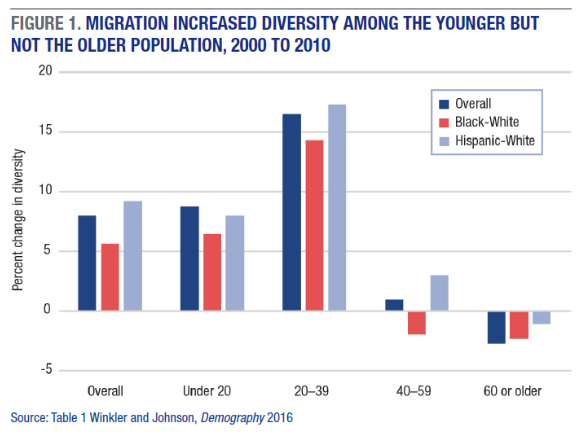Migration, especially by young adults, is increasing racial and ethnic diversity in US counties
As we related last week, a new report from the Urban Institute quantifies the stark economic costs of racial and income segregation in the United States. Places with higher levels of segregation have lower incomes for African-Americans, lower rates of educational attainment, and higher rates of serious crimes. Reducing segregation by race and class is an important and unfinished agenda for achieving greater social justice, and improving our economy.
But how can we reduce segregation? As we all know, its difficult and expensive to build new housing in established neighborhoods. There’s often opposition to new development, whether its infill housing in cities, or affordable housing in suburbs. But while the housing stock can change only slowly, the occupants of housing units are changing all the time–the average renter has lived in her apartment less than two years, for example. The critical question is whether the regular and on-going movement of people in and out of different housing and different neighborhoods is reinforcing existing patterns of segregation, or whether its creating greater diversity.
A new report–Moving to Diversity–from the Richelle Winkler a sociologist at Michigan Technological University, and Kenneth Johnson, a demographer at University of New Hampshire, looks at the way in which population movements are changing the face of America’s counties. Counties turn out to be a convenient unit for analysis, because its possible to accurately separate out the effects of births, deaths and net migration by race and ethnicity. The report looks at population change between 1990 and 2010, and focus on four broad racial-ethnic categories: non-hispanic whites, non-hispanic blacks, hispanic persons, and all other racial-ethnic combinations. To compute the effects of migration, the authors calculate what each county’s demographics would look like based on its racial and ethnic composition in the base year (for example 1990) forecast forward simply to reflect the effects of births and deaths of the base year population. The difference between that estimate and the actual observed value in the end year (for example 2000), is the net effect of migration on county demographics.
The report offers several key insights into the ways in which migration is influencing the racial and ethnic composition of different counties. First, its the movement of younger people, especially young adults which is contributing to the big increases in county-level diversity. The movement of those 20-39 accounted for the biggest changes in both black-white and hispanic white diversity. Moves by older adults actually tended to decrease racial and ethnic diversity (think white people moving to even “whiter” counties, and so on). But overall, the trend toward greater diversity is driven by the young, who are both more likely to move, and when they move, tend to move to more diverse locations.

There are important city-to-suburb and suburb-to-city components to migration. Young white people contribute to greater diversity by moving from whiter counties (disproportionately in suburbs) to urban counties that tend to have more persons of color. Conversely, Black and Hispanic migrants exhibit net migration in the other direction, from less white urban counties to whiter suburban ones. The effect of both kinds of migration is to increase diversity in both counties. As Winkler and Johnson explain:
Blacks and Hispanics of all ages migrated to areas that were “whiter,” thereby increasing diversity. The movements of the white population have been more complex, however, with impacts that vary considerably by age. White young adults (age 20–39) moved from predominantly white counties to counties with larger black and Hispanic population shares, often in large urban centers. The net flow of white young adults into central-city counties increased the white young adult population there by approximately 20 percent in the 1990s and again in the 2000s. The outflow of these same young white adults from suburban and rural counties to big urban cores also contributed to more diversity in these origin areas by diminishing the number of whites there.
While the overall effect of migration was to increase integration by race and ethnicity, this didn’t occur everywhere. Winkler and Johnson estimate that migration significantly increased diversity in about 10 percent of counties, a modestly increased diversity in about 56 percent of counties, had little effect one way or another in about 32 percent of counties, and resulted in noticeably less diversity in only about 2 percent of counties.
The distinct age structure of these migration trends suggests that future migration will also tend to increase diversity. Young people are much more likely to migrate than older ones. The persistence of the migration of white young adults to cities, coupled with the migration of persons of color to suburbs makes both areas more diverse than they would otherwise have been.
In the face of a growing body of evidence on the negative effects of segregation, its good to know that the individual migration decisions of people in the up and coming generations are contributing to growing diversity at the county level in the US.
